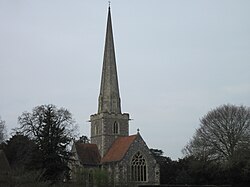Shottesbrooke
| Shottesbrooke | |
| Berkshire | |
|---|---|
 St John the Baptist Church at Shottesbrooke Park | |
| Location | |
| Grid reference: | SU8477 |
| Location: | 51°29’10"N, -0°47’17"W |
| Data | |
| Population: | 141 (2011) |
| Post town: | Maidenhead |
| Postcode: | SL6 |
| Dialling code: | 01628 |
| Local Government | |
| Council: | Windsor and Maidenhead |
| Parliamentary constituency: |
Maidenhead |
Shottesbrooke is a village in Berkshire. The parish is mostly rural: 88% covered by agriculture or woodland and had a population of 141 at the 2011 census.
Geography
Shottesbrooke is a parish between Waltham St Lawrence on the west and White Waltham on the east. They were originally one place, Waltham, which was divided perhaops in the Anglo-Saxon era. Today, as always, it is mostly farmland with some large areas of woodland in between, particularly the Great Wood. The hamlet of Cold Harbour is in the very north of the parish, with Shottesbrooke itself in the central area, between Shottesbrooke Park and Smewins' Farm, where the B3024 runs through the region.
The M4 motorway crosses the southeast corner of the parish.
Parish church
The parish church was built as an ecclesiastical college in 1337 by Sir William Trussell, the lord of the manor and a prominent diplomat. It is of the Decorated Period and renowned for its fine memorial brasses and Trussell's beautifully carved double-recessed monument.
Towards the end of the reign of King Edward III, the church and college were almost destroyed by fire, but from the design of the existing church the damage done must have been almost entirely confined to the secular buildings.
The building is remarkable both for its beauty and symmetry of design and its present good state of preservation. It is recorded that on Wednesday, 20 July 1757, a violent thunderstorm passed over 'Shottesbrook' and the church was so damaged by the lightning that it had to be shut up for more than a year, during which time the parishioners attended White Waltham. The church re-opened on Sunday, 24 September 1758, after repairs. The chief damage appears to have been done to the spire, which was so shaken that it was at first thought that it would have to be taken down. A gallery across the north transept (evidently an 18th-century addition, removed in 1854) was also damaged and so too the north porch. The falling stones from the spire slightly damaged the roof setting a few rafters on fire.
In 1852–4 the church was thoroughly restored under the supervision of G. E. Street, R. A.[1] Between 1870 and 1872 the village real property of £2,134 had 148 residents spread over 23 homes, fewer than 50% of the current number.[2] Most adult residents in the 1871 census were employees at the few large houses and their associated farms.[3]
History
The Roman 'Camlet Way' between St Albans and Silchester would have crossed the parish at some point and the name 'Cold Harbour' indicates there was an inn or other stopping place nearby. In Saxon times, the manor was owned by the Royal goldsmiths and 'Alward the Goldsmith' was one of the few Saxons allowed to keep his manor here after the Norman Conquest. It is said that charcoal from the Great Wood which occupies most of the southern third of Shottesbrooke was used to melt the gold to make the Saxon Royal regalia.[4]
Shottesbrooke was created a parish, endowed with its own church and priest mainly because of national wealth and later accomplishments of successive owners of Shottesbrooke Park.[5] It was the home of Sir William Trussell, a prominent Royal diplomat in the mid-14th century, who built the parish church as an ecclesiastical college in 1337.[6]
A 17th century Speaker of the House of Commons, Henry Powle, lived at the Park.[7] He was followed by Francis Cherry, the non-juror (unwilling to override his oath of recognition of the legal right to reign of the deposed Roman Catholic monarch, James II)[8] and guardian of Thomas Hearne and patron of Francis Brokesby.[9] His friend, Henry Dodwell, the theologian, lived at Smewins.[10] Later, Governor Henry Vansittart was in residence[11] and his brother, Professor Robert Vansittart also grew up there.[12] Until his death in 2007, the Park was the home of their heir and relation-by-marriage, Sir John Smith, the founder of the Landmark Trust which has its headquarters in the adjoining farmhouse.
Outside links
| ("Wikimedia Commons" has material about Shottesbrooke) |
- Royal Berkshire History: Shottesbrooke
- Royal Berkshire History: Shottesbrooke Park
- Royal Berkshire History: Shottesbrooke Church
References
- ↑ Parishes: Shottesbrook - A History of the County of Berkshire: Volume 3
- ↑ Extract from Vision of Britian, University of Portsmouth John Marius Wilson. Imperial Gazetteer, 1870-72.
- ↑ UK Census online (subscription required) Retrieved 2014-11-25
- ↑ Shottesbrooke - Royal Berkshire History
- ↑ Shottesbrooke Park - Royal Berkshire History
- ↑ Shottesbrooke Church - Royal Berkshire History
- ↑ Henry Powle (1630–1692) - Royal Berkshire History]
- ↑ Francis Cherry (1665–1713) - Royal Berkshire History
- ↑ Thomas Hearne (1678–1735) - Royal Berkshire History
- ↑ Samuel Lysons (1806). Magna Britannia;: being a concise topographical account of the several counties of Great Britain. Printed for T. Cadell and W. Davies. p. 405. http://books.google.com/books?id=W3kgAQAAMAAJ&pg=PA405. Retrieved 30 August 2013.
- ↑ |title=Henry Vansittart (1732–1770) - Royal Berkshire History
- ↑ Robert Vansittart (1728–1789) - Royal Berkshire History